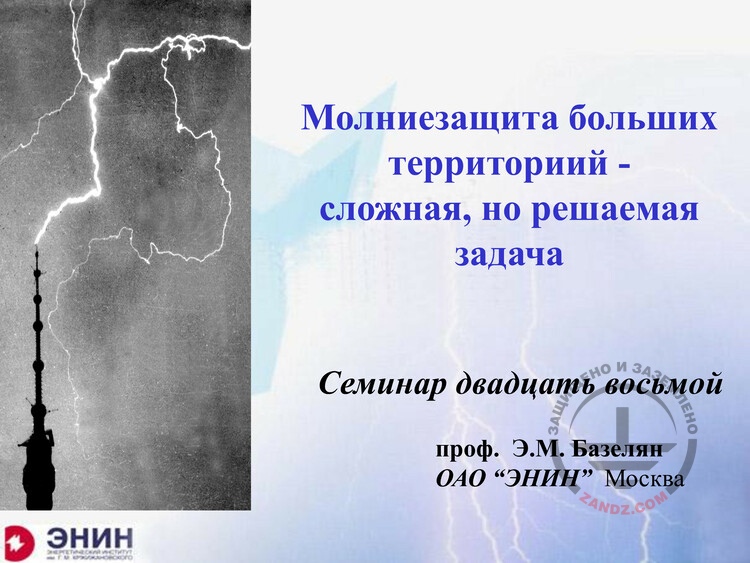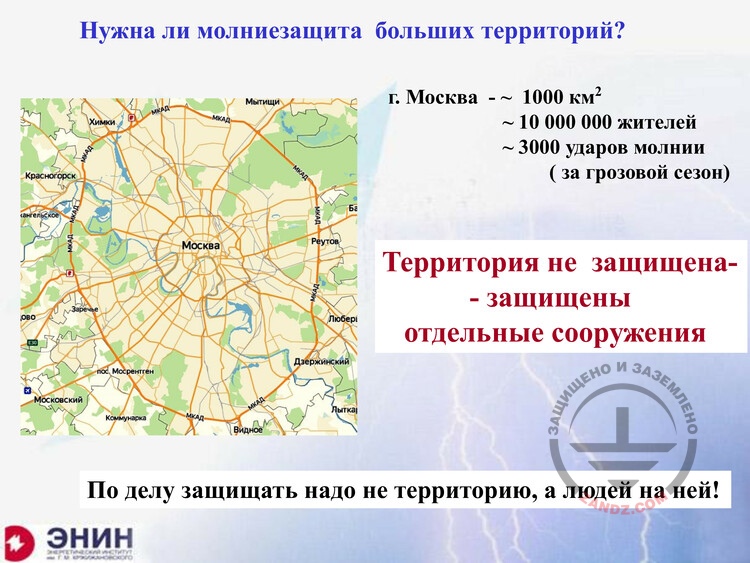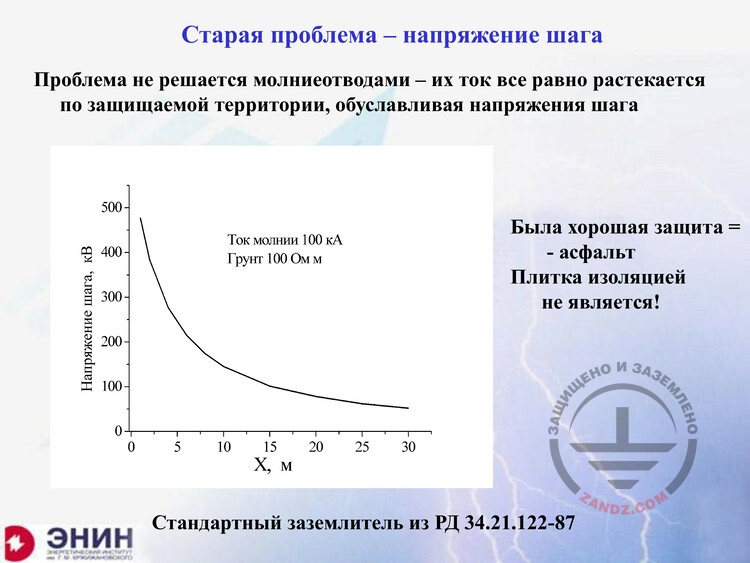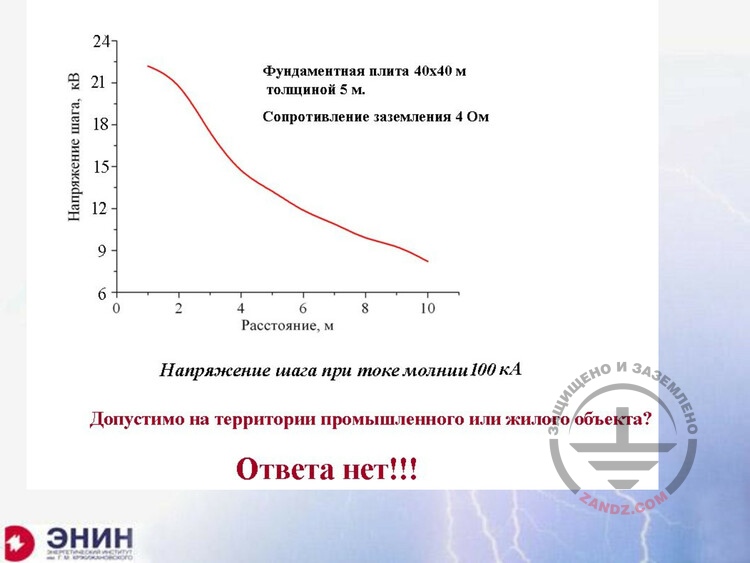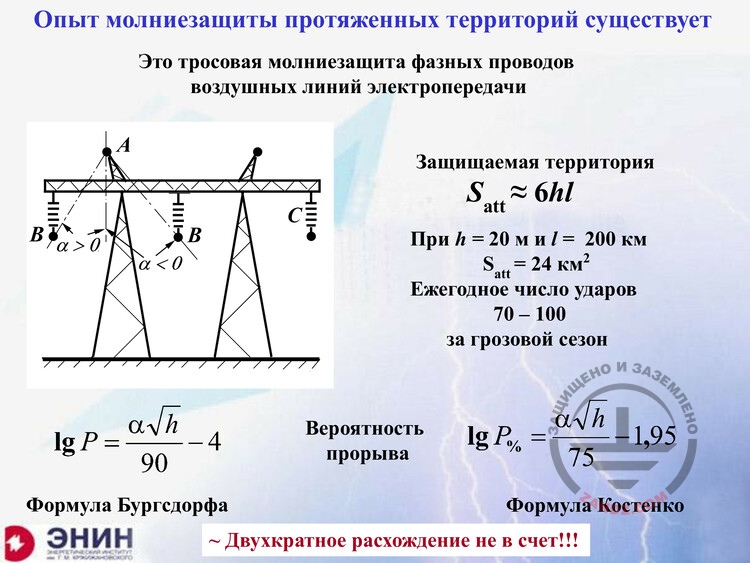(held on June 19, 2019 at 11:00)
The most important question is whether we should protect large territories against lightning, and if so, then what territories and how. The first thing that comes to my mind is parks and forest lands. They are the easiest to study and to make sure that you do not need to install the lightning protection here if you understand how to behave during the storm properly.
However, the experience of protection of large territories has been accumulated, and on its basis almost all methods for the lightning protection evaluation are tested today. We are talking about air high voltage power lines. Their controlled length is several hundred thousand kilometers. During the storm season, the line of about 100 km long collects several dozens of lightning strikes. To protect it, the wire lightning arresters are used, for which the calculation technique is well elaborated. Unfortunately, we have to admit that the designers do not want to use the experience of the use of ground wires for other technical objects. Large areas of electrical substations, tank farms, oil processing stations are still for no reasons protected using rods instead of wire arresters. This is expensive and not very reliable.
In the recent years, we have managed to demonstrate that the protective action of the wire lightning arrester system (a multi-wire system) could be significantly improved due to the shielding effect of the volume crown charge that is excited in the electrical field of the thundercloud without any additional high-voltage sources. The use of the system of the crown ground wires allows not only protect a large territory against the direct lightning strikes with the reliability not less than 0.999 but also significantly reduce the electromagnetic interference to the electrical circuit of the protected object.
These and other questions related to the lightning protection of large territories will be described in more details by Professor Eduard Meerovich Bazelyan during the webinar.
1080p full screen watching is recommended.
Webinar text. Page 1
Fast navigation by slides:
Page 1:
1. Lightning protection of large territories
2. Do we have to protect the large territories against lightnings?
3. Same old song: step voltage
4. Step voltage with the lightning current 100 kA
5. Lightning protection of forests and parks is pointless
6. Experience of lightning protection of extended territories is available
Approximate reading time: 27 minutes.
Lightning protection of large territories: parks, grounds, plant territories
Молниезащита больших территориий - сложная, но решаемая задача - Lightning protection of large territories is a complex but solvable task
Семинар двадцать восьмой - The twenty-eighth seminar
проф. Э.М. Базелян - Prof. E.M. Bazelyan
ОАО “ЭНИН" Москва - OAO “ENIN” Moscow
Do we have to protect the large territories against lightnings?
Нужна ли молниезащита больших территорий? - Do we have to protect the large territories against lightnings?
г. Москва - ~ 1000 км2 - Moscow: ~ 1,000 km2
~ 10 000 000 жителей - ~ 10,000,000 residents
~ 3000 ударов молнии (за грозовой сезон) - ~ 3,000 lightning strikes (for a storm season)
Территория не защищена – защищены отдельные сооружения - The territory is not protected, only separate structures are protected!
По делу защищать надо не территорию, а людей на ней! - In fact, you have to protect people rather than territory!
Frankly speaking, when I was preparing for the webinar, I had many doubts. These were the doubts of the following kind: do we have to protect large territories at all? What are we talking about? I have imagined a large territory. It is inside the Moscow Ring Road, the area is about 1,000 km2, i.e. it is Moscow. Actually, it is even more because Moscow expanded beyond these kilometers long ago. Ten million residents, about 3,000 strikes per year. What should we protect? Each building? It is protected. Each of them is protected by default, and if it is not, then Gostekhnadzor will not put it into operation and we will have no subject to discuss. Therefore, if we are talking about large territories, then what are these territories? The following point occurs: these territories are where we walk, and we need to protect ourselves instead of territories. What should we protect from? It is clear that from the step and touch voltage. And the task is what we have already discussed several times. We have already discussed that the step and touch voltage is not a very pleasant and, unfortunately, not a very well understood thing.
Same old song: step voltage
Старая проблема - напряжение шага - Same old song: step voltage
Проблема не решается молниеотводами - их ток все равно растекается но защищаемой территории, обуславливая напряжения шага - The problem is not solved with lightning arresters: their current flows in the protected territory anyway, thus causing the step voltage
Напряжение шага, кВ - Step voltage, kV
Ток молнии 100 кА - Lightning current 100 kA
Грунт 100 Ом м - Soil 100 Ohm m
Х, м - X, m
Была хорошая защита – асфальт - There was a good protection — asphalt
Плитка изоляцией не является! - The tiles do not provide insulation!
I have provided the following example: a good soil 100 Ohm*m, it is essentially a black soil, a conventional lightning arrester is installed to protect the territory. Such lightning arrester has an earthing device made according to the strict standards of the regulatory document RD 34, i.e. a horizontal band, three vertical rods, all of these are according to the standard. And now I am showing to you the way the step voltage changes versus the distance to the base of the lightning arrester. Look, at the distance of 10 meters, it is about 10 kV, and at the distance of 30 meters, it is about 50 kV. You know, it is not a good situation to be exposed to such voltage. Now, what was used as a protection? A recommendation was provided to protect: filling with the soil having a high resistivity, primarily stones, and then the asphalt above. If you provide an asphalt protection, then the asphalt has the thickness of 10 cm; if it has no cracks, then it is a very good protection. But today, each city has the tile production plant, and it is owned by the people having a good reputation in the city; therefore, in many cities, including Moscow, the asphalt is replaced by tiles. And the tiles are not insulation for the following reason. The tile itself is an insulator, but the tiles are laid with a step, with spacings, wherein a typical soil is present to drain water. Therefore, when a person stands on the tiles, he/she is not on the insulator but essentially on the soil. And it appears in this situation that people are generally almost unprotected.
Step voltage with the lightning current 100 kA
Фундаментная плита 40 х 40 м толщиной 5 м. - Foundation plate 40 x 40 m with the thickness 5 m
Сопротивление заземления 40 м - Earthing resistance 40 m
Расстояние, м - Distance, m
Напряжение шага при токе молнии 100 кА - Step voltage with the lightning current 100 kA
Допустимо на территории промышленного или жилого объекта? - Is it allowable in the territory of industrial or residential facility?
Ответа нет!!! - No answer!!!
Before the webinar, while we were talking here, I was asked the following question: "There are many high-rise buildings with good foundations, and the foundation is an earthing device for this house; so, probably, there cannot be any step voltage?" And in order to show if it can or cannot, I want to show you the chart provided here. A high-rise building is installed on a reinforced concrete plate as a foundation having the thickness of 5 meters. The dimensions of the plate are 40 x 40 meters and now, I am calculating these overvoltages, which occur at different distances from this foundation plate upon the exposure of the lightning current 100 kA. The plate itself provides a good earthing resistance of 4 Ohm only. At the distance of only 10 meters, it is about 7 kV to 8 kV, and at the distance of 5 meter, it is about 15 kV. The question is: what happens to the people when they are exposed to this voltage? I cannot answer this question. I do not know what happens to them because I do not know how the voltage of this level acts for a very short exposure time. The standards for the electrical safety are limited to the time of one hundredth of a second. And here, we have one ten thousandth of a second rather than this, i.e. about 100 mcs. But it is clear that the exposure will be weaker, but anyway, what kind of exposure will it be? What will happen to a person? What will happen to a child? We cannot answer this question today. We cannot find these materials in our country. I have tried to look for them abroad. But I have not found anything important. Only in the German document, I have read that the voltage of 6 kV of the storm overvoltage with the exposure time of about 100 mcs may cause the heart defibrillation in several per cent of cases. It means that the voltage of about 6 kV is dangerous. If these research is really serious. And if it is, then the lightning protection of large urban territories will be reduced to the following: we have to create a normal lightning current flowing or provide insulation of the locations wherein a large number of people is concentrated. For example: monuments, churches, mosques; I would avoid laying the tiles there. In any case, the asphalt is much more preferred.
Lightning protection of forests and parks is pointless
Молниезащита лесов и парков лишена смысла - Lightning protection of forests and parks is pointless
Практически однородный лесной массив по плотности ударов молнии не отличается от плоской поверхности земли - In terms of the lightning strike density, almost uniform forest land does not differ from the planar earth surface
Наиболее опасна опушка, а кроме того особо высокие деревья - The forest margin is the most dangerous as well as very tall trees
Числи ударов увеличивается только на опушке, где - Number of strikes is only increased in the margin, where
Now, for some reason, the golf fields are mentioned. Frankly speaking, I have seen a golf game only once and even that was abroad. The golf field is a really large territory with the trees. Parks are a little bit different from the golf fields. As well as the forest lands. I have never heard that it is feasible to protect forest lands against the lightnings. However, I do not know how to do that. Although, honestly, once I saw a letter from a person who installs geodetic towers, and he offered to make these wooden geodetic towers and lay a metal current wire thereon, install a rod, and these rods will function as the lightning arrester that will protect the forest lands. A drawback is only in that the distance between these geodetic towers covers kilometers or even dozens kilometers. And if you install them, you will not be able to protect anything. You will only protect very small pieces of the forest. What does a forest mean for the lightning? If you have a forest land that is more or less uniform, then the number of strikes per a square kilometer of this forest land will not differ in any way from the lightning strike into a plain area that is neither built nor planted. It is because such a plain area elevated over the earth for 20 meters will not be interesting for the lightning, it will be just an uniform earth surface. And the number of strikes will be the same. In Russia, it is 3 to 4 strikes per 1 km2 of the surface. What is really dangerous for the people? The forest margins are dangerous for the people. Why? It is because, from one side, the 20 m high trees are located with a plain surface being on the other side. And these trees on a plain surface have a collection radius equal to three heights of these trees in the margin. As a result of this, in the forest land, a margin is dangerous, although nobody will protect it anyway; however, is really dangerous. And if you get into the storm in the forest land or in a park, and you have no way to go, go away from this margin, this is the only thing you can do. And very tall trees are also dangerous. But in Russia, we have no very tall trees like sequoias. Our trees are of about the same height; therefore, neither parks nor forest lands will be protected, and it is generally not needed.
Experience of lightning protection of extended territories is available
Опыт молниезащиты протяженных территорий существует - Experience of lightning protection of extended territories is available
Это тросовая молниезащита фазных проводов воздушных линий электропередачи - This is a wire lightning protection of phase wires of air power lines
Защищаемая территория - Protected territory
При h = 20 м и l = 200 км - With h = 20 m and l = 200 km
24 км2 - 24 km2
Ежегодное число ударов - Annual number of strikes
За грозовой сезон - For a storm season
Вероятность прорыва - Breakthrough probability
Формула Бургсдорфа - Burgsdorf formula
Формула Костенко - Kostenko formula
~ Двухкратное расхождение не в счет! - ~ Two-fold difference does not matter!
What is a large protected territory? Certainly, the power lines with the voltage class of 110 kV and more. This is a really large territory. The supports of the power lines have a height with the wire hangs of about 20 meters. The length of the power line of class, e.g. of 220 kV, will be no lower than 100 km or even 200 km. And it means that the power lines are a territory with an area of about 20 km2 to be protected along the entire length. And all power lines of this voltage class are protected with either one or two ground wires. We have an international organization CIGRE, i.e. a commission for large electrical grid that accumulates the experience of protection of such power lines using ground wires. And the statistics have been accumulated not for only dozens square kilometers but for hundred thousand square kilometers multiplied by the service year. These data are summarized with the calculation formulas that are created by the Russian specialists. There is a Burgsdorf formula that provides the lightning breakthrough probability through the wire protection to the wires. There is a Kostenko formula that provides the same dependence. These formulas generally differ only within 2. This 2-fold error in the lightning protection is not an error. I should say that all calculation techniques available in the world, including the probabilistic technique, which is used in Russia, it was checked and calibrated precisely for the operation experience of the power line. We have no more reliable data. And we use these data to design any lightning protection, including wire and rod protection. The point is that these are the most representative data we have today.
Next page >>
slides from 7 to 12
Related Articles:
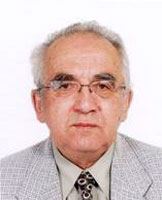 Lightning protection of residential and public buildings - answers to frequently asked questions in the design
Lightning protection of residential and public buildings - answers to frequently asked questions in the design


 Lightning Protection of Large Territories: Parks, Grounds, Plant Territories. Page 2
Lightning Protection of Large Territories: Parks, Grounds, Plant Territories. Page 2
 Lightning Protection of Large Territories: Parks, Grounds, Plant Territories. Page 3
Lightning Protection of Large Territories: Parks, Grounds, Plant Territories. Page 3


